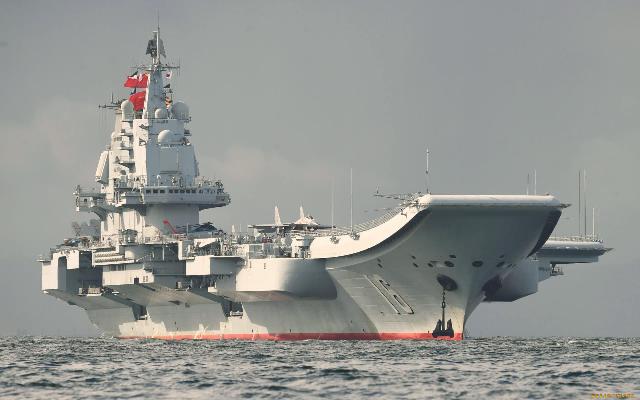The rapid economic development of the People's Republic of China is increasingly affecting the growth of the capabilities of its armed forces. Today, one of the directions for the development of the PLA's combat potential is the formation of aircraft carrier strike groups as part of the Chinese Navy. The aircraft carrier Liaoning opens a series of articles on this topic.
According to Japanese military experts, the military and political leadership of the People's Republic of China has repeatedly authorized the development of an aircraft carrier by the forces of the national defense industrial complex.
The first attempt to design a ship for simultaneous actions of aviation and amphibious forces was made within the framework of the "Project 707". The project was approved in July 1970, closed in September 1971. Work on a new ship to ensure aviation operations was designated "Project 891" (approved in January 1989, closed in 1998).
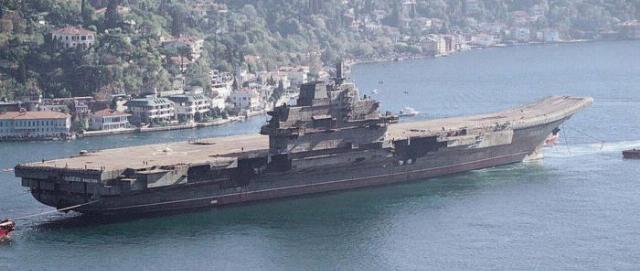
TAVK "Varyag"
Obviously, the curtailment of the second development took into account the acquisition in 2002 in Ukraine for $ 20 million of the unfinished Soviet heavy aircraft carrier missile cruiser Varyag. The ship was towed to the Shipyard No. 1 in Dalian (northeast China). Ukrainian shipbuilders were also invited to the plant. The latter operated under the cover of a company that repairs ships under the Register.
Chinese experts admit that close acquaintance with the ship and its designers allowed them to save 8-10 years only on research and development work. According to Chinese sources, the PLA Navy Command made the decision to repair and modernize the Varyag on April 26, 2005.
The aircraft carrier Liaoning received its name on September 25, 2012 in honor of the province in which Dalian is located
The main technical characteristics of aircraft carriers of the Liaoning type
| Type | Aircraft Carrier |
| Operator | PLA Navy |
| Manufacturer | Dalian Shipbuilding Industry Company (Dalian, China) |
| Crew, team / air wing, people. | 1960 / 626 |
| Commissioning | September 25, 2012 |
| Status | In the ranks |
| Dimensions and displacement | |
| Length, m | 304,5 |
| Width, m | 75 |
| Draft, m | 10,5 |
| Full displacement, t | 55 000 / 70 500 when fully loaded |
| Propulsion system and seaworthiness | |
| Propulsion system | 4 x KTA TV-12 8 x Diesel KTA |
| Total power, hp | 150 000 + 50 000 |
| Speed, knots | 32 |
| Cruising range, nautical miles | 8 000 |
| Autonomy | Up to 45 days |
| Aviation Wing | |
| Istr.-bombs. "Jian-15"/J-15, units. | 24 |
| Z-18 AWACS helicopters, units | 6 |
| PLO Z-18F helicopters, units | 6 |
| PPP Z-9S helicopters, units | 2 |
| Total number, units. | Up to 40 |
| Armament | |
| Rocket | 3 x PU ZUR HQ-10 "Marine Red Banner – 10" |
| Artillery | 3 x 30mm 11-barrel melee system "Type 1130" |
The main stages of construction
To modernize the aircraft carrier, an indoor assembly shop and a dry dock were built on the territory of the shipyard. Their length is 400 and 360 m, respectively. These facilities will allow the construction of larger nuclear aircraft carriers in the future.
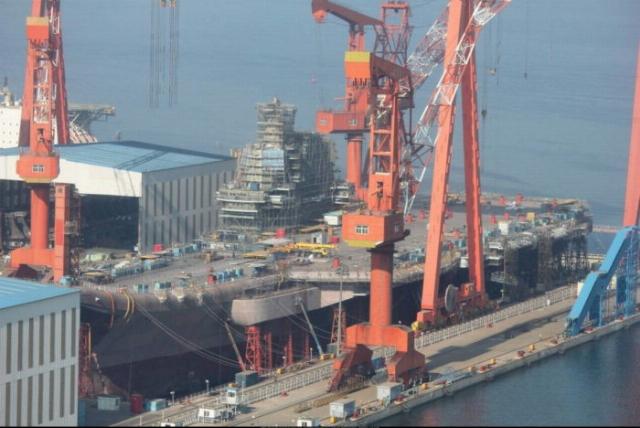
At the shipyard in Dalian
We will note the main milestones in the completion and preparation of the first aircraft carrier of the PLA Navy.
The future aircraft carrier Liaoning was brought into dry dock in April 2005 to inspect the underwater part and begin work on the slipway. The work was actually completed by July 27, 2011. The total cost of the work carried out is estimated at 10 billion. yuan. During this period, Chinese shipbuilders from Dalian and Shanghai underwent serious practice. According to calculations by Chinese engineers, the Liaoning aircraft carrier, which was officially commissioned into the PLA Navy on September 25, 2012, should serve for 35 years.
As a result of the redesign of the ship's interior and the installation of modern digital equipment, the standard displacement of the Liaoning is 55 thousand tons. Its total displacement reaches 67.5 thousand tons. The crew consists of one thousand people.
Sea trips
The ship sailed on its maiden voyage on October 30, 2012. A month later, on November 23, 2012, naval aviation pilots on Jian-15 heavy fighters made their first landings on deck. As of September 21, 2013, the pilots of the first regiment of carrier-based fighter aircraft had completed 100 takeoffs and landings. This made it possible to test the brake cable system for strength in high-intensity flight conditions.
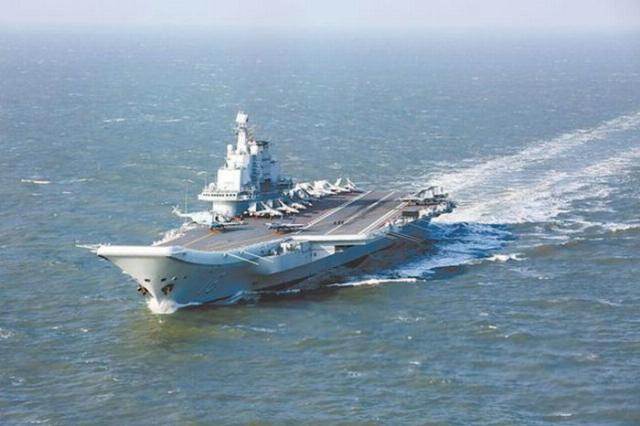
Aircraft Carrier Liaoning
The aircraft carrier Liaoning embarked on a 37-day training and test cruise on January 2, 2014. During the campaign, the first crew of the ship gained experience in using radio navigation systems, checked all installed radars, the flight control system (SUP), and worked out the actions of the deck crew.
The experience of the US Navy was used in organizing the work of the ship's crew. This means that all crew members, depending on their purpose, wear vests of a certain color: white – air traffic control group, red – weapons, purple – fuel, green – maintenance and repair, etc.
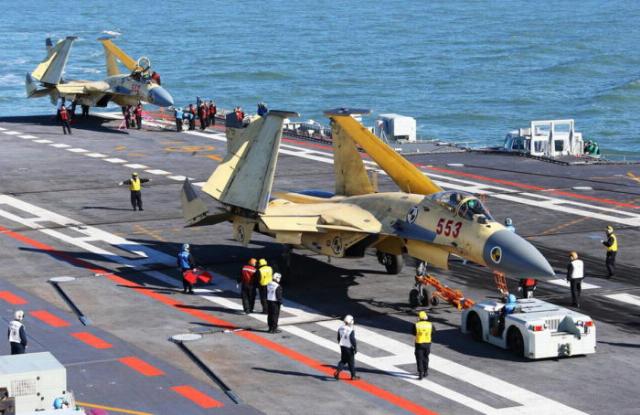
On the deck of the Liaoning aircraft carrier
With regard to the aircraft carrier Liaoning, it is known that one shift consists of six military personnel. They are monitoring the situation on deck using 16 high-resolution video cameras. Information from the cameras is transmitted to four large-format monitors. In addition, at the disposal of the SOUP duty shift is a transparent scale model of the flight deck and hangar, which reflects the current situation on the ship.
The Liaoning aircraft carrier is the core of AUG
On December 24, 2015, the first exercises were held to coordinate the actions of the crews of warships of the promising aircraft carrier strike group (AUG) The PLA Navy. In addition, control measures for the training of the second group of carrier-based fighter pilots were carried out.
A year later, on December 23, 2016, the first carrier-based aviation exercises took place over the Yellow Sea. During the event, fighter pilots performed aerial refueling and conducted several training battles against a mixed squadron of the Eastern Fleet of the PLA Navy.
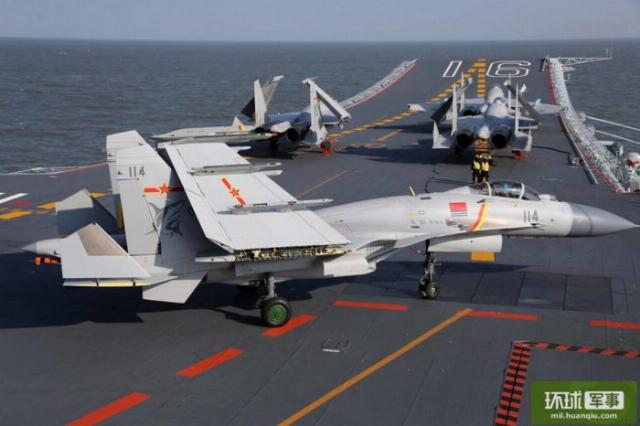
Fighters on the deck of the Liaoning
It should be noted that the crews of the ships began preparing for these training battles on December 15, 2016. During the preparatory period, the following were worked out:
- issues of early detection of air targets and early warning of an air attack;
- electronic interception of targets;
- electronic missile launches against surface ships of a simulated enemy;
- missile defense techniques.
According to the results of these trainings, on January 2, 2017, the Liaoning Aviation Group began new training activities, but now over the waters of the South China Sea.
AUG formation
As part of the subsequent AUG exercises of the PLA Navy, the destroyers of Project 052C Changchun, Jinan and Yantai were introduced into its composition. The ships of this project form the basis of the AUG air defense.
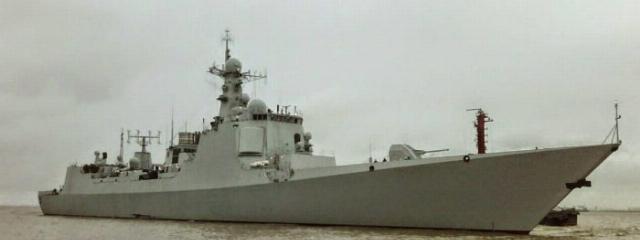
Destroyer of the 052C project
In April 2018, the PLA Navy AUG conducted joint exercises with the Air Force. Their goal was anti-submarine defense and repelling massive raids by bomber aircraft of a likely enemy. The tasks of the exercises were worked out in the waters of the South China and East China Seas, as well as in the western Pacific Ocean.
Currently, the aircraft carrier Liaoning is located at the mooring wall of the shipyard in Dalian. The ship is waiting for the replacement of the three-axis radar for long-range detection of air targets, some units and electronic systems with more modern ones
Aircraft carrier Liaoning: design features
It is known that Chinese and Ukrainian specialists did not redo the flight deck and left a springboard with an elevation of 14 degrees. However, a complete replacement of the ship's air defense system has been carried out. Some experts in China argue that Chinese designers have oversimplified and even weakened it. The ship was equipped with only three 30 mm eleven-barreled anti-aircraft guns H/PJ-11 (also known as "Type 1130") and three mechanized missile launchers "Marine Red Banner 10".
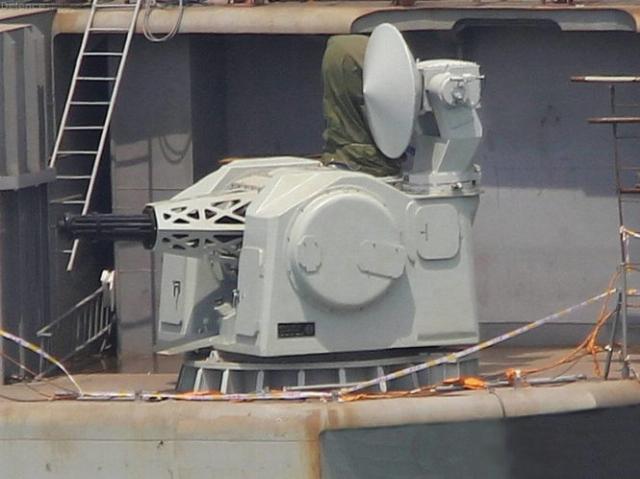
Anti-aircraft gun type 1130
Engines and fuel
Chinese specialists in the field of marine power plants were able to copy Soviet-made boiler turbine units (KTA). In China, they received the designation TV-12 (according to other sources TY-12).
According to Chinese sources, the Liaoning aircraft carrier received four KTA TV-12 with a total capacity of 150 thousand hp. Additionally, 8 more high-pressure KTA (powered by diesel fuel) are installed, which provide another 50 thousand hp.
This KTA complex allows Liaoning to confidently maintain a speed of 30 knots for five hours. It should be noted that Chinese engineers are carefully analyzing the capabilities of the Russian-made KVG-6M KTA (they have three-dimensional drawings and drawings). In their opinion, the units will allow the only Russian aircraft carrier to show all its capabilities.
The standard and maximum capacity of fuel tanks (fuel oil) is 6 thousand and 8 thousand tons, respectively. According to the estimates of observers of military-technical publications of China, it takes from three (with high-pressure KTA working) to 10 hours to fully prepare an aircraft carrier for a campaign.
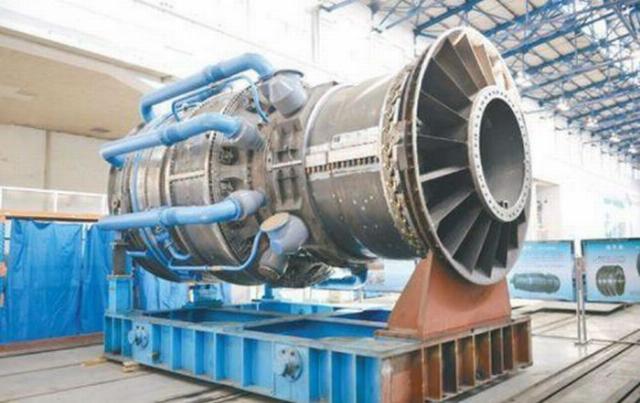
The prototype of the GTD R0110
It is known that Chinese experts are working on the possibility of using two heavy-duty R0110 gas turbine engines. According to the conducted tests, the engines develop a maximum power of 150 thousand hp (114500 kW) and have a resource of 200 thousand hours.
Two such GTE will allow the Liaoning aircraft carrier to easily reach a speed of 35 knots, and heavier promising ships will provide a speed of 30 knots. It should be noted that the appearance of such turbines, as well as the mass production of some components of deck-based fighters, became possible after the appearance in China of a hydraulic press providing a pressure of 80 thousand tons.
Calculations, calculations According to data obtained during several naval combat training campaigns, at a constant speed of 18 knots (the minimum allowed speed for deck fighter flights), the ship consumes 390 tons of fuel oil. This allows him to cover about 780 km. Thus, one refueling in the amount of 6 thousand tons for such an aircraft carrier as Liaoning is enough only for 12 days of the campaign.
At a fuel oil price of 2,169 yuan per ton, the cost of such a short-term trip to the sea is 13 million yuan, or about 130 million rubles. Traditionally, the duration of the training and combat campaign of the aircraft carrier Liaoning is 38-40 days. At the same time, the maximum combat radius of the ship is more than 4,200 miles. The cost of marine fuel alone for such a period of combat training reaches 31 million yuan or 310 million rubles.
Aviation Group
According to Japanese sources, Chinese and Ukrainian designers decided to partially remove the vertical launchers of P-700 anti-ship missiles placed under the flight deck.
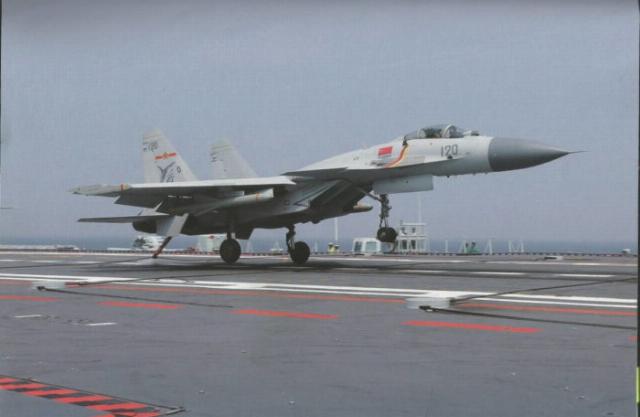
Jian-15 heavy carrier-based fighter
However, even this small upgrade made it possible to increase the capacity of the aircraft hangar. As a result, it became possible to deploy 24 Jian-15 heavy fighters, i.e. a standard regiment consisting of three squadrons. With the price of one Jian-15 fighter about 400 million yuan, the cost of a regimental set (25 aircraft) reaches 10 billion. yuan, and the brigade (36 aircraft) is already 15 billion. yuan.
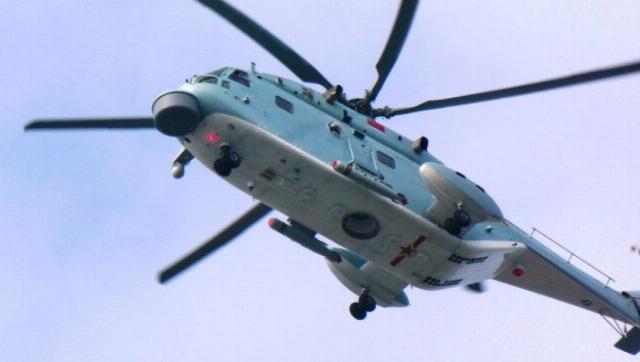
PLO Z-18F Helicopter
In addition to aircraft, the Liaoning aircraft carrier has 12 helicopters for various purposes as part of the carrier-based air group. Among them are six Z-18F anti-submarine warfare helicopters, four Z-18Y long-range radar patrol helicopters and four Z-9C search and rescue helicopters.
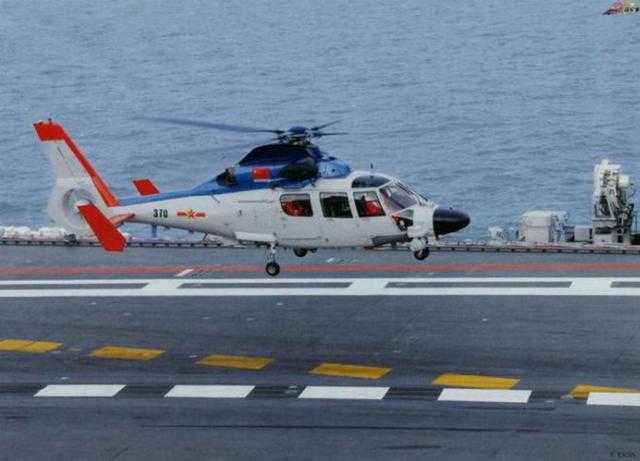
PSS Z-9C Helicopter
At the same time, during all combat training campaigns, only half of the specified number of rotorcraft was deployed on the ship. It should be noted that most surface ships of the PLA Navy have Z-9 "Black Panther" type PLO helicopters, which in the future can be replaced by heavier Z-20s.
Helicopter PLO Z-20
Preliminary results and prospects
It seems possible to argue that almost five years after commissioning, the Liaoning aircraft carrier justified the cost of its creation. The ship allowed:
- prepare the first fully combat-ready regiment of carrier-based aviation pilots;
- train instructors for training units;
- check the reliability of the landing system components;
- conduct exercises as part of an aircraft carrier strike group, as well as interspecific exercises with the PLA Air Force and solve other tasks.
According to specialized publications of the People's Republic of China, the Chinese military and shipbuilders are considering several options for upgrading the Liaoning as a future training ship.
As part of the first option, it is proposed to increase the flat part of the flight deck by dismantling several air defense systems. The exhaust shields from the two far starting positions will also be removed.
According to the second option, it is planned to replace the springboard part of the deck with a straight line and install two electromagnetic catapults (EMC) on the ship.
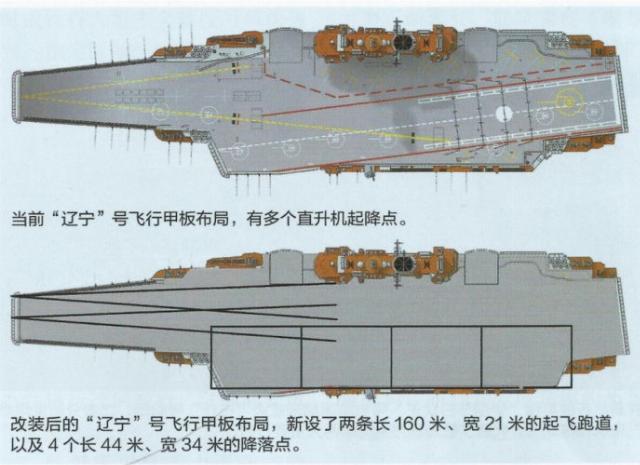
The ship's modernization scheme. At the top there is a modern flight deck plan, at the bottom there is the prospect of expanding the deck and shifting the starting positions
Basically, all EMC systems and components are modular and mounted in the frames of standard 40 and 20 foot shipping containers. The exception is the guide line, which will have to be embedded in the deck of an aircraft carrier. For this decision, a group of researchers from the National Academy of Sciences of the People's Republic of China under the leadership of academician, Rear Admiral Ma Weiming received a state prize.
Based on the materials of the magazine "Ship armament". Beijing. Publishing house of the Chinese Shipbuilding Industrial Corporation.
On the subject of aircraft carriers of the Chinese Navy:
